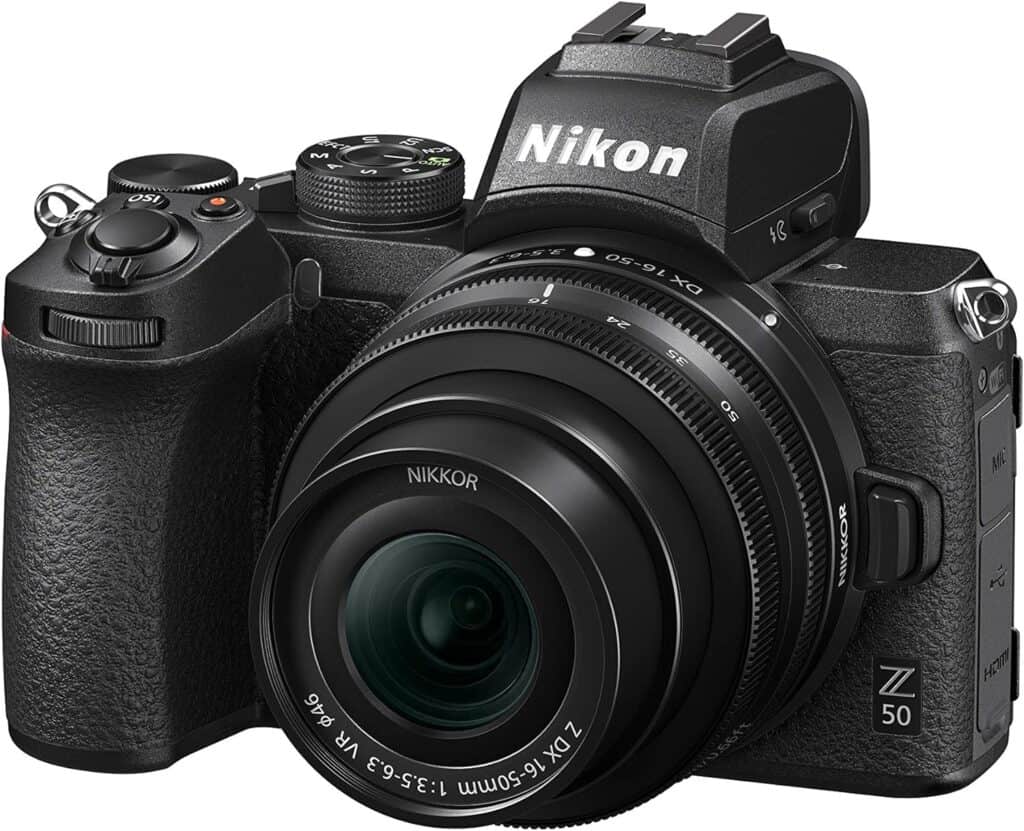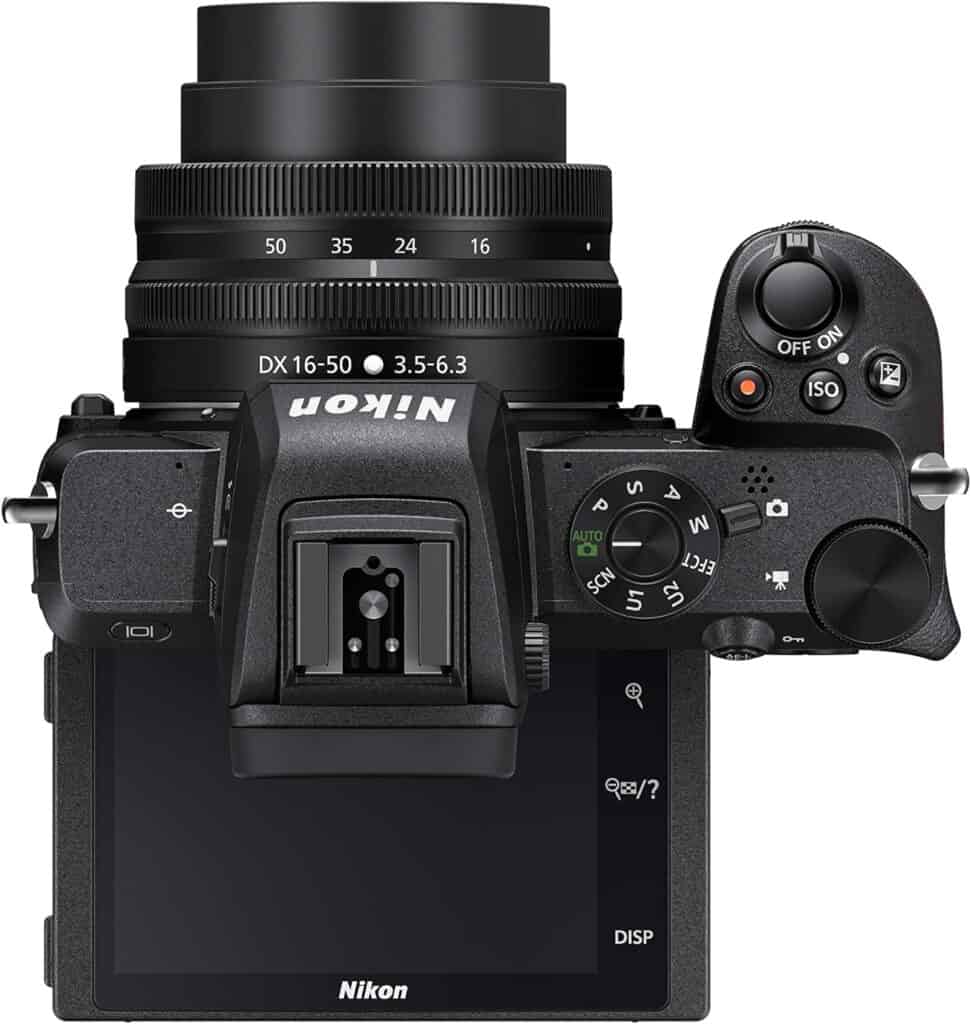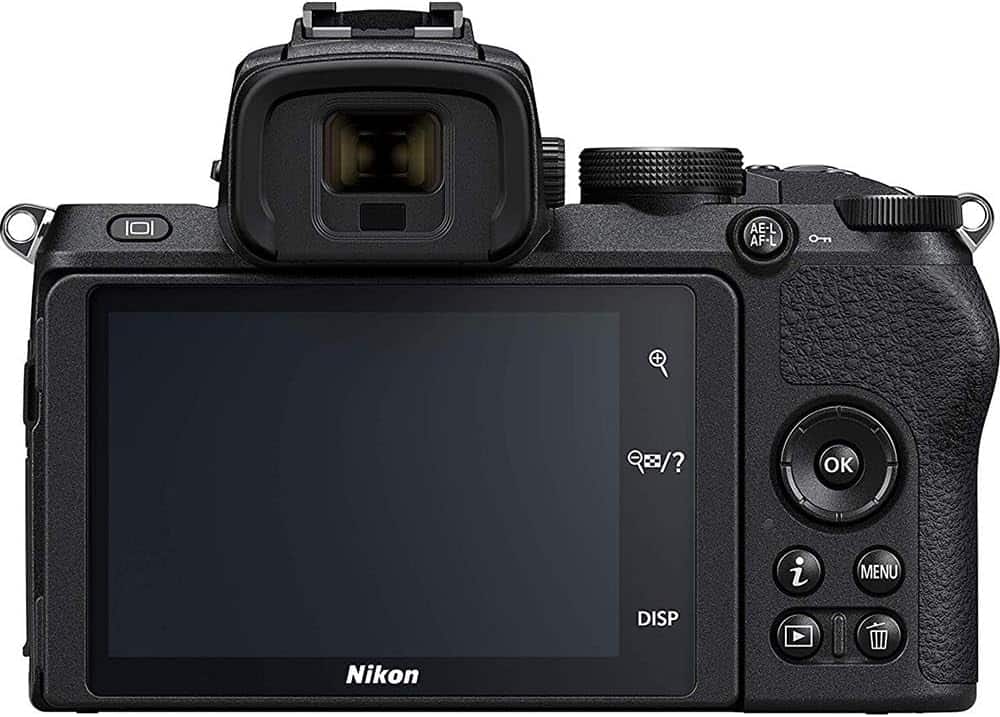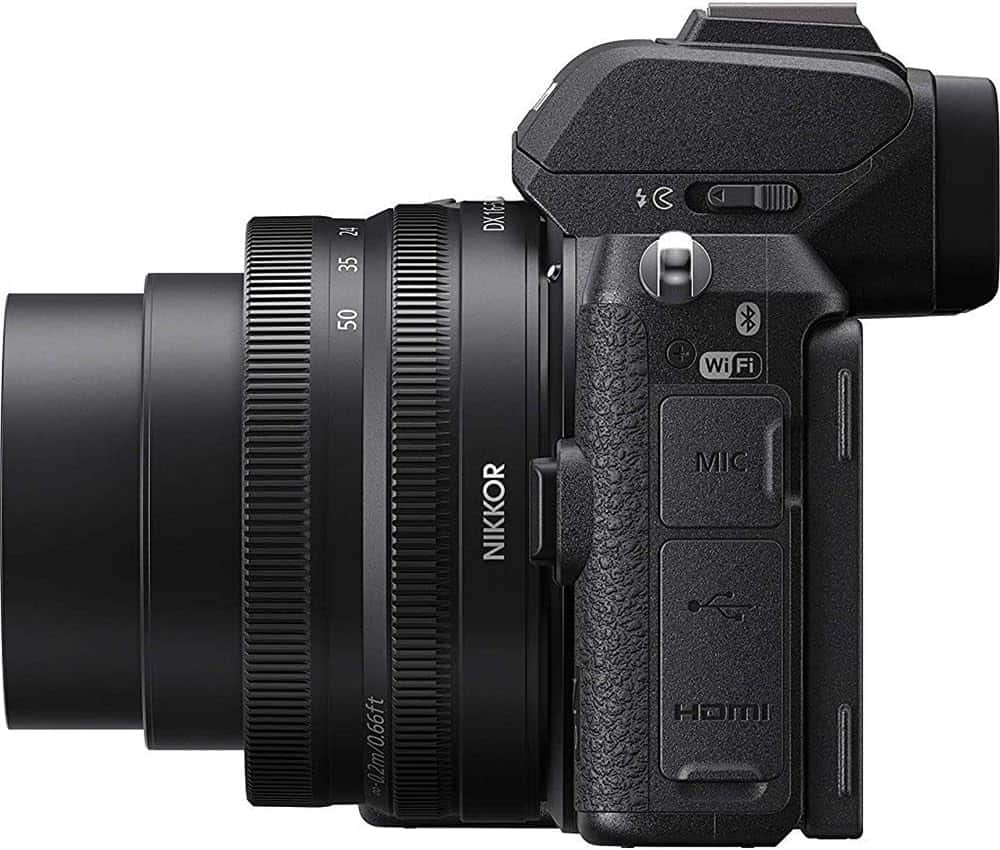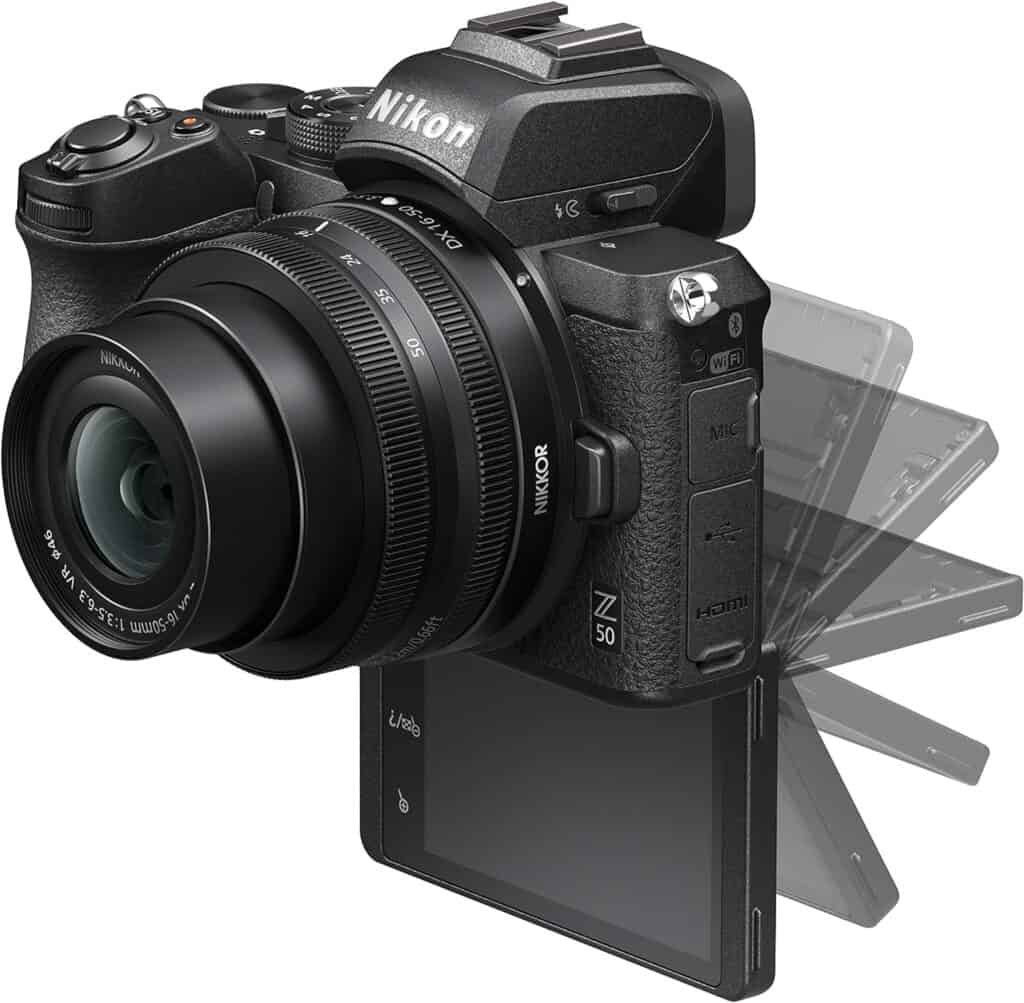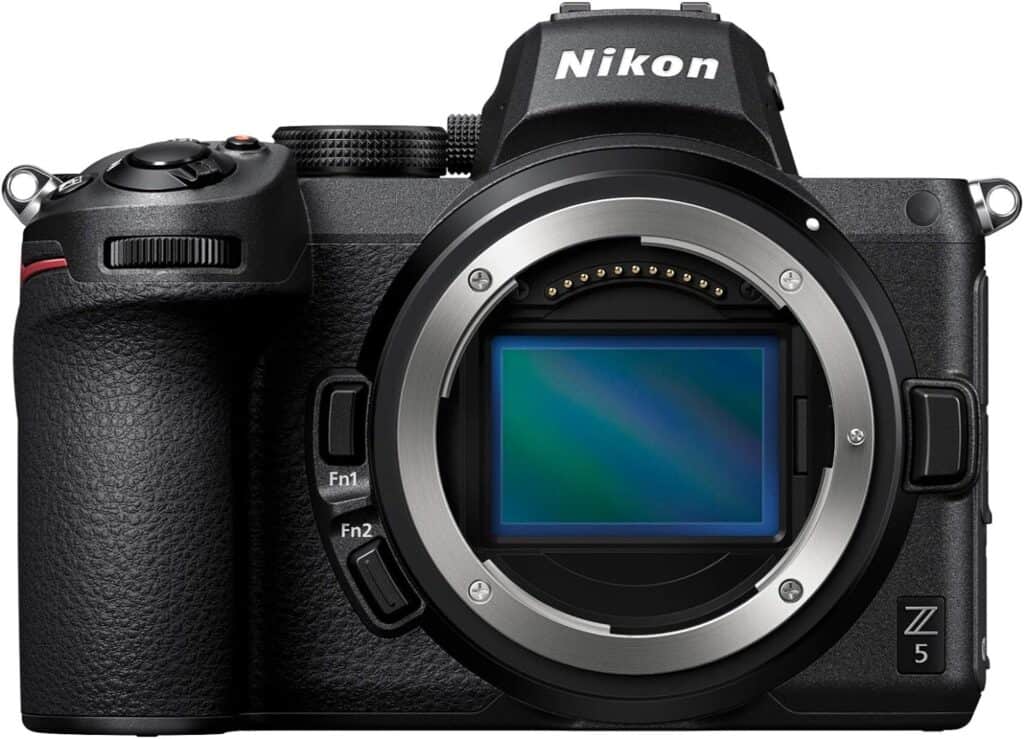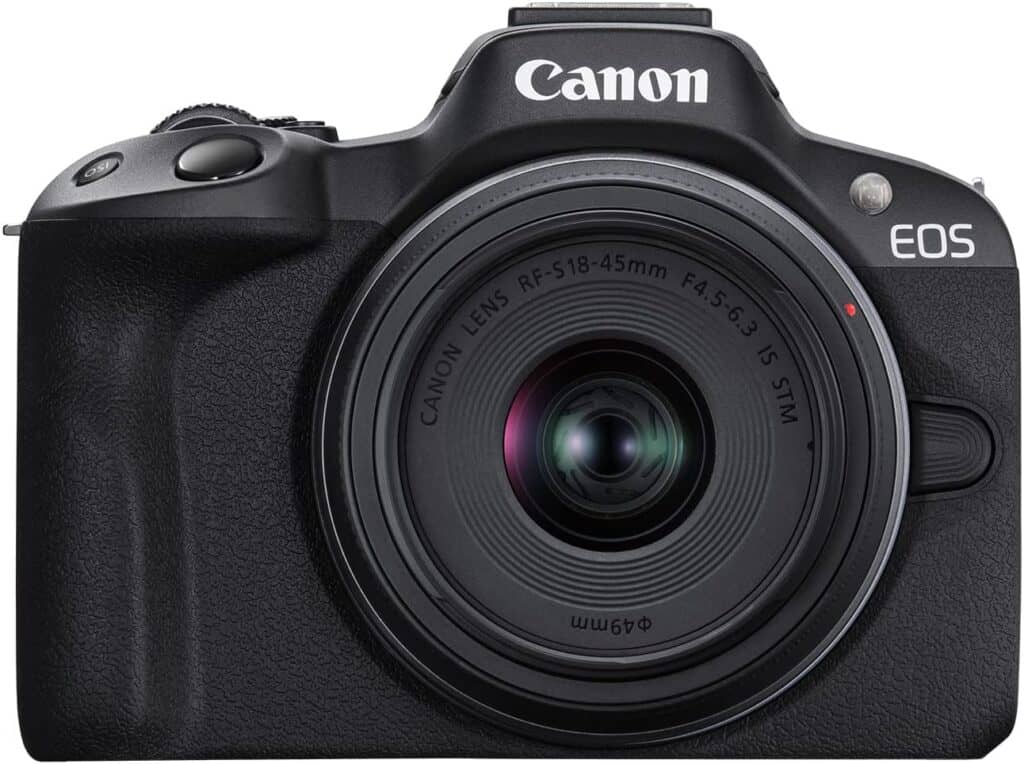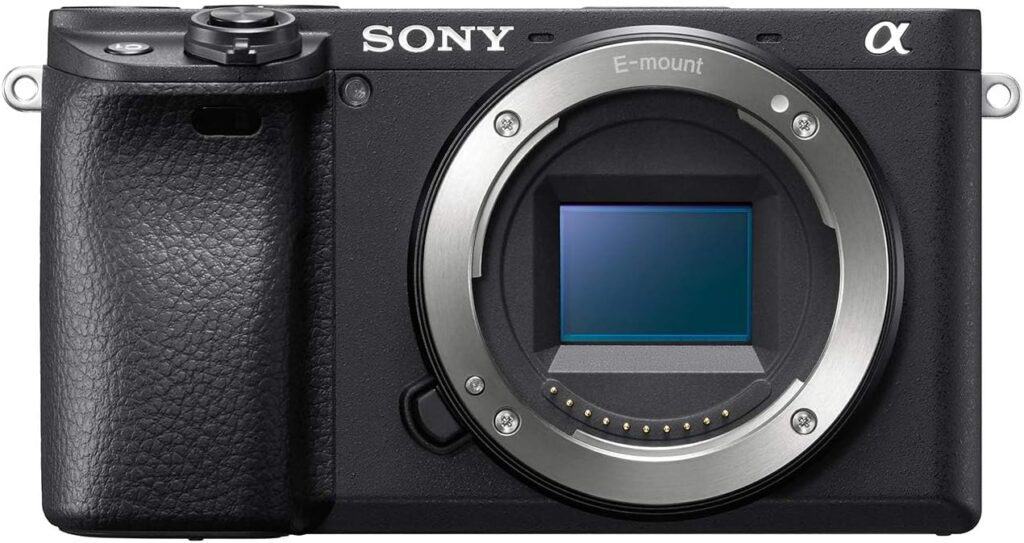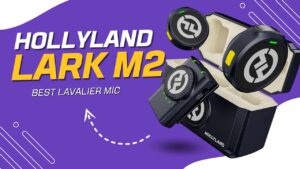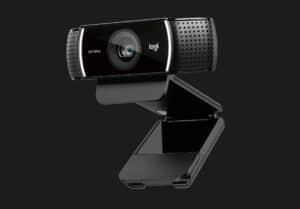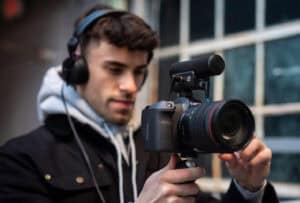In this Nikon Z50 review, we’ll explore why this compact mirrorless camera has become a popular choice among content creators. Building on Nikon’s rich history of producing exceptional cameras, the Z50 combines robust performance with user-friendly features, making it a versatile tool for podcasters, YouTubers, and photographers alike.
Our Verdict

The Nikon Z50 is an excellent choice for content creators, offering impressive image quality, reliable autofocus, and a user-friendly interface in a compact and lightweight design. While it lacks in-body stabilization and has a single card slot, its overall performance and versatility make it a strong contender for podcasters, YouTubers, and photographers alike.
Pros
- Excellent image and video quality
- Compact and lightweight design
- Reliable autofocus with eye-detection
- User-friendly interface with tilting touchscreen
Cons
- No in-body image stabilization
- Single SD card slot
- Moderate battery life
Nikon Z50 Overview
The Nikon Z50 is a compact mirrorless camera that builds on Nikon’s legacy of high-quality imaging devices. As part of the Z series, it represents Nikon’s push into the mirrorless market, following the success of their full-frame Z6 and Z7 models. Designed with content creators in mind, the Z50 combines Nikon’s renowned image quality with a user-friendly design.
Design and Build
The Nikon Z50 boasts a sleek and compact design that feels solid in the hand, despite its lightweight construction. The magnesium alloy body gives it a durable feel. The deep grip ensures a comfortable hold during extended shooting sessions.
The camera’s layout is intuitive, with well-placed buttons and dials that are easily accessible. The tilting touchscreen is a standout feature.
Controls and Handling
The controls on the Nikon Z50 are designed for both beginners and experienced users. The mode dial and customizable buttons provide quick access to essential functions. The electronic viewfinder is bright and clear, offering a precise view of your scene, while the touch interface makes adjusting settings on the fly straightforward.
For those who prefer manual control, the Z50 offers an array of options, from manual focus to exposure settings. The camera’s ergonomics ensure that it fits comfortably in your hand.
Sensor and Image Quality
At the heart of the Nikon Z50 is a 20.9-megapixel APS-C sensor, which delivers stunning image quality with excellent detail and vibrant colors. This sensor, paired with Nikon’s EXPEED 6 image processor, ensures fast performance and low noise even in low-light conditions.
The 4K UHD video capability is a huge plus for YouTubers and video podcasters. The camera’s ability to capture high-quality stills is a great bonus for creating engaging thumbnails and promotional images.
Autofocus
The Nikon Z50 features a sophisticated autofocus system with 209 focus points that cover a wide area of the frame. It excels in both photo and video modes, with quick and accurate eye detection autofocus that’s particularly useful for vlogging and interviews. The camera’s ability to track moving subjects is impressive.
Live Streaming
Live streaming with the Nikon Z50 is straightforward, thanks to its compatibility with Nikon’s Webcam Utility software. This feature allows you to use the camera as a high-quality webcam.
The Z50’s excellent video quality, combined with its ability to connect to your computer via USB, makes it a perfect tool for live streaming on platforms like YouTube and Twitch. The compact design and ease of use mean you can set up a professional-looking stream without needing extensive equipment or technical know-how.
Power and Connectivity
While the Nikon Z50’s battery life might not be the longest, it’s sufficient for most typical recording sessions, and USB-C charging offers a convenient solution for longer shoots. The camera must be turned off to charge, so you can’t shoot continuously, so you may opt to buy a second battery that can be charged while you’re shooting.
For connectivity, the Z50 comes equipped with Wi-Fi and Bluetooth. The camera also features a microphone input, which is essential for capturing high-quality audio to match your video. With HDMI output, you can connect the Z50 to an external monitor for a more robust setup.
Storage
The Nikon Z50 uses SD cards for storage, specifically supporting UHS-I cards which offer a good balance between speed and affordability. With a single card slot, it’s important to invest in high-capacity and high-speed cards, especially if you plan to shoot a lot of 4K video or high-resolution stills.
For podcasters and YouTubers, this setup is quite adequate, but it’s always a good idea to have multiple cards on hand to ensure you never run out of space during critical moments.
Viewfinder
The Nikon Z50 is equipped with a 2.36-million-dot OLED electronic viewfinder (EVF) that provides a bright and clear view of your scene. This EVF is especially useful for shooting in bright outdoor conditions where the LCD screen might be hard to see.
The viewfinder’s high resolution ensures that you can see fine details and focus precisely. If you prefer composing shots traditionally, the EVF is a standout feature that enhances the overall shooting experience.
Battery
The Nikon Z50 uses the EN-EL25 rechargeable lithium-ion battery, which is compact and lightweight. While the battery life is rated at around 300 shots per charge, actual performance can vary based on usage, particularly when shooting video or using live view extensively. For podcasters and YouTubers, it’s best to have a spare battery on hand to avoid interruptions.
What’s in the Box of the Nikon Z50?
When you purchase the Nikon Z50, the box includes:
- Nikon Z50 Camera
- NIKKOR Z DX 16-50mm f/3.5-6.3 VR Lens
- EN-EL25 Rechargeable Li-ion Battery
- MH-32 Battery Charger
- USB Cable
- Strap
- Body Cap
- Rubber Eyecup
Specifications of the Nikon Z50
Here are the key specifications of the Nikon Z50:
- Sensor: 20.9 MP APS-C CMOS sensor (DX-format)
- Image Processor: EXPEED 6
- ISO Range: 100-51,200 (expandable to 204,800)
- Autofocus: Hybrid AF with 209 focus points, including eye-detection AF
- Continuous Shooting Speed: Up to 11 fps with full AF/AE
- Video Recording: 4K UHD at 30p, Full HD at 120p for slow motion
- Viewfinder: 2.36-million-dot OLED electronic viewfinder
- LCD Screen: 3.2-inch, 1.04-million-dot tilting touchscreen LCD
- Connectivity: Wi-Fi and Bluetooth for wireless file transfer and remote control
- Ports: Microphone input, HDMI output, USB Type-C
- Storage: Single SD card slot, compatible with UHS-I cards
- Battery: EN-EL25 rechargeable lithium-ion battery, approximately 300 shots per charge
- Dimensions: 126.5 x 93.5 x 60 mm (5.0 x 3.7 x 2.4 inches)
- Weight: Approximately 450 grams (15.9 ounces) with battery and memory card
Who is the Nikon Z50 For?
The Nikon Z50 is an excellent choice for a variety of content creators, particularly those in the following categories:
Podcasters: With its high-quality video capabilities and external microphone input, the Z50 ensures that your video podcasts look and sound professional. The camera’s compact size and ease of use make it perfect for setting up in a home studio.
YouTubers: Whether you’re vlogging, creating tutorials, or producing cinematic content, the Z50’s 4K video, reliable autofocus, and vibrant image quality will help elevate your videos. Its tilting touchscreen is ideal for framing shots when you’re in front of the camera.
Vloggers: The Z50’s portability, combined with its excellent autofocus and image stabilization when paired with the right lenses, makes it a great option for vlogging. The camera’s lightweight design ensures that it’s easy to carry around and use for extended periods.
Beginner and intermediate photographers: For those looking to step up from a smartphone or basic point-and-shoot camera, the Z50 offers a significant upgrade in terms of image quality and creative control, without being overly complicated.
Social media influencers: The camera’s ability to quickly transfer high-quality images and videos via Wi-Fi and Bluetooth makes it convenient for influencers who need to share content promptly on various social media platforms.
Nikon Z50 Alternatives
If the X-T30 isn’t right for you, check out some of these popular alternatives:
Nikon Z5
The Nikon Z5 is a full-frame mirrorless camera, unlike the APS-C sensor in the Z50. This gives the Z5 better low-light performance and a wider field of view with the same lens.
Additionally, the Z5 features dual SD card slots for more storage flexibility and in-body image stabilization (IBIS), which the Z50 lacks. However, the Z5 is bulkier and more expensive, making it less portable.
Canon R50
The Canon R50 is another APS-C mirrorless camera but tends to be more beginner-friendly with a simplified interface. The R50 offers excellent dual pixel autofocus, which is renowned for its accuracy and speed, especially in video mode.
However, it lacks some of the Z50’s build quality and ergonomics, making the Nikon Z50 more appealing to those who prioritize handling and durability.
Sony A6400
The Sony A6400, like the Nikon Z50, has an APS-C sensor and is known for its fast and reliable autofocus system with Real-time Eye AF and Real-time Tracking. The A6400 features a 180-degree flip-up screen, making it particularly good for vlogging.
It lacks in-body image stabilization, similar to the Z50, but offers slightly better battery life and a wider selection of native lenses in the Sony E-mount ecosystem. The A6400’s menu system is often criticized for being less intuitive compared to Nikon’s.
Nikon Z50 Review FAQs
Here are some common questions people ask about the Nikon Z50:
What is the Nikon Z50’s weakness?
The Nikon Z50’s main weakness is its lack of in-body image stabilization, which means you have to rely on lens-based stabilization for steady shots.
Can you use the Nikon Z50 for professional photography?
Yes, the Nikon Z50 is capable of professional photography, particularly for genres like portrait, street, and travel photography, thanks to its high-quality sensor and robust feature set.
Is the Z50 an entry-level camera?
The Nikon Z50 is considered more of an advanced beginner to mid-level camera, offering features that appeal to both novices and more experienced photographers.
Which is better, the Nikon Z30 or the Z50?
The Nikon Z50 is generally considered better than the Z30 due to its superior build quality, electronic viewfinder, and additional features, making it more versatile.
Does the Nikon Z50 have image stabilization?
The Nikon Z50 does not have in-body image stabilization; it relies on lens-based stabilization for reducing camera shake.
Does the Nikon Z50 have built-in autofocus?
Yes, the Nikon Z50 has a built-in hybrid autofocus system with 209 focus points, including eye-detection AF.
Does the Nikon Z50 support 4K video recording?
Yes, the Nikon Z50 supports 4K UHD video recording at 30 frames per second, providing high-quality video for content creators.
How long does the Nikon Z50 battery last?
The Nikon Z50’s battery life is rated at approximately 300 shots per charge, though actual performance may vary depending on usage, especially when recording video.
Is the Nikon Z50 good for vlogging?
Yes, the Nikon Z50 is great for vlogging, thanks to its compact size, excellent video quality, reliable autofocus, and tilting touchscreen that makes framing shots easy.
Should You Buy the Nikon Z50?
Whether to buy the Nikon Z50 depends on what you’re looking for in a camera. If you’re a podcaster or YouTuber, the Z50 is a solid choice due to its high-quality 4K video and impressive still image capabilities. Its compact and lightweight design makes it perfect for creating content without feeling weighed down, whether you’re in a studio or on the move.
The camera’s user-friendly interface, with intuitive controls and a tilting touchscreen, allows for quick adjustments, making it accessible for both beginners and more experienced users. The reliable autofocus system, including eye-detection AF, ensures your subjects stay sharp, which is especially useful for vlogging and interviews.
However, there are some potential drawbacks to consider. The single SD card slot might be limiting if you require extensive storage or backup options during shoots.
Additionally, while the battery life is decent, you may need a spare battery for longer recording sessions. The absence of in-body image stabilization means you’ll rely on lens-based stabilization, which could be a consideration if you often shoot handheld.
Overall, if you need a reliable, high-quality camera that offers great performance without breaking the bank, the Nikon Z50 is an excellent choice.
If you found this review helpful, please check out some of our other camera reviews:
